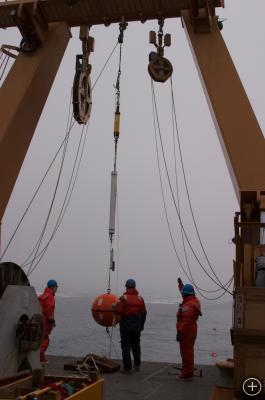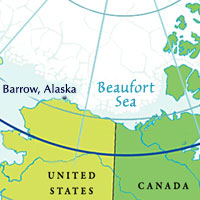Ears of the Deep, Part II: Mooring Technology
ABOARD THE USCGC HEALY, ON THE BEAUFORT SEA– My last dispatch discussed the work of scientist Kate Stafford, who uses sets of acoustic sensors called hydrophone arrays to listen to the sounds of whales, dolphins, and other marine life. These sensors are placed on moorings, the subject of today’s dispatch.
Mooring Technology
In oceanography, moorings are used to hold instruments in a fixed location and, typically, at a fixed pre-determined depth. I say “typically” because we shall in future dispatches see how some special instruments with limited but very useful mobility can be used to measure ocean characteristics at a range of depths over time. These designs can be somewhat more complicated to design and deploy.
A typical mooring is a collection of lines or cables with an attached set of instruments and floats, and a device called an acoustic release (“release” for short). At the bottom is a heavy weight (“anchor”) placed on the sea floor. The mooring design/deployment sheet for Kate’s mooring was designed at he University of Washington’s Applied Physics Lab and can be seen here.

Mooring with acoustic release, audio recorder, CTD (conductivity, temperature, and depth measurement instrument) and float ready for deployment; the recovery line and its floats are already in the water.
This mooring includes 3 meters of Amsteel line, a type of line with a very high strength-to-weight ratio. A Benthos 866A release combines the acoustic release and transponding functions together in one device (see below). (Teledyne-Benthos is one of several companies that make these types of devices).
Kate’s recording instruments are Aural M-2 autonomous audio recorders made by the Canadian company Multi-Electronique. Each includes an HTI-96 hydrophone manufactured by High Tech Inc. that can measure sound in the 2Hz to 30KHz frequency range. The recorders can sample the signal from the hydrophone up to a rate of 32KHz at 16 bits per sample. Kate has set up the recorders to operate 10 minutes out of every half hour.
When one of Kate’s moorings is recovered, its year-long recording resides in a storage system within the instrument. The storage system includes both a flash based storage device as well as a conventional hard drive. The 64MByte flash device makes no sound when written to, so this is advantageous when measuring sound. The hard drive stores more information, but makes noise when operating that is detectable by the hydrophone. Thus, is it desirable to write data as it is recorded to the flash device and later, when the hydrophone is inactive, transfer the data to the hard drive for longer-term storage.
To power the system, the instrument includes 128 ‘D’ cell batteries. In its current configuration, the hard drive will fill up before the battery power is exhausted. Before the hard drive fills up (hopefully), the instrument itself must be retrieved in order to avoid losing data. This is one of the reasons for Kate’s work on Healy– to recover instruments deployed a year earlier and deploy new ones to last another year.

 No comments
No comments 








